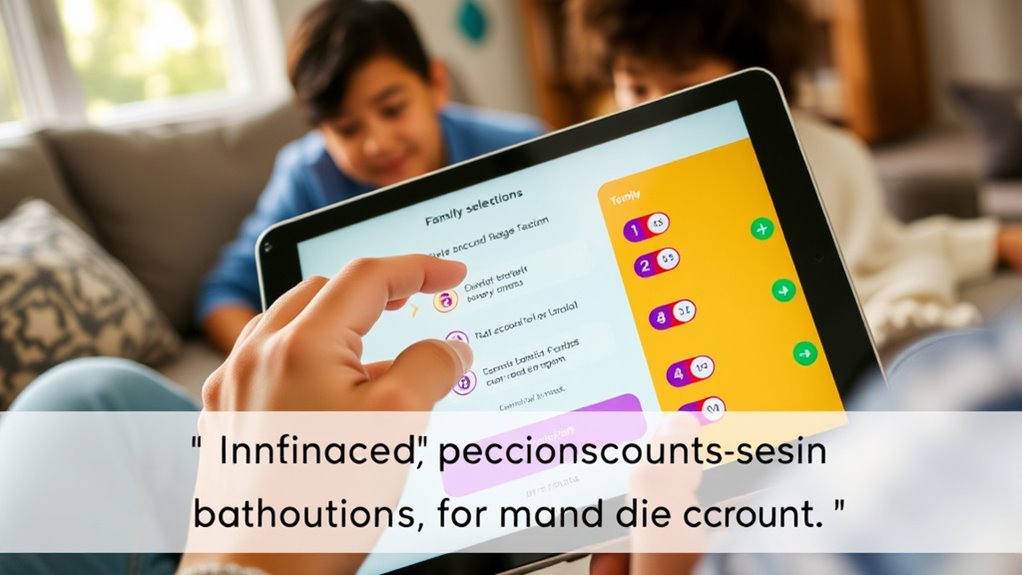To enable consent-based data sharing in family accounts, you should create clear, user-friendly interfaces that allow each member to set and manage their permissions easily. Transparently communicate how data is shared, stored, and protected, ensuring everyone understands their options. Incorporate legal and security best practices to build trust, and regularly review permissions to keep privacy settings up-to-date. Continuing familiarizes you with key strategies to implement effective consent mechanisms seamlessly.
Key Takeaways
- Obtain clear, informed consent from each family member before sharing their data, emphasizing transparency and understanding.
- Use simple, accessible language in privacy policies and permission prompts to ensure all members comprehend data sharing practices.
- Implement role-based permissions to control access levels, allowing members to manage their own sharing preferences securely.
- Regularly review and update consent preferences, notifying family members of any changes to ensure ongoing transparency.
- Incorporate security measures like encryption and audits to protect shared data, building trust through transparent data handling practices.
Understanding the Importance of Consent in Family Data Sharing

Understanding the importance of consent in family data sharing is essential because it guarantees that everyone’s privacy rights are respected. When you share data within a family, each member has different comfort levels and expectations about privacy. By obtaining clear consent, you ensure that no one’s information is shared without permission. This not only fosters trust but also helps avoid misunderstandings or conflicts later. Consent acts as a safeguard, giving family members control over their personal details. It emphasizes transparency, making it clear what data will be shared and with whom. When you prioritize consent, you create a respectful environment where everyone feels empowered and protected, reinforcing the importance of privacy in family relationships. Additionally, understanding cookie consent management helps ensure that data sharing practices are aligned with privacy preferences and legal standards.
Challenges in Implementing Consent-Based Mechanisms

Implementing consent-based mechanisms in family data sharing often encounters several obstacles. One major challenge is managing varying levels of understanding among family members. Different ages and tech literacy levels can lead to confusion or misinterpretation of consent options. Privacy concerns also arise, especially when sensitive data is involved, making it difficult to balance transparency with protection. Additionally, establishing clear processes for obtaining and updating consent can be complex, especially in dynamic family situations. Technical limitations, such as integrating consent workflows into existing platforms, further complicate implementation. Ensuring that all family members feel their preferences are respected without overwhelming them with unnecessary prompts demands careful planning. Overcoming these obstacles requires thoughtful strategies to make consent meaningful, accessible, and adaptable. For example, addressing privacy concerns is crucial because sensitive data requires careful handling to prevent misuse or unauthorized access.
Designing User-Friendly Consent Interfaces

When designing consent interfaces, you need to make permission requests clear and straightforward so users understand what they’re agreeing to. Creating intuitive flows helps users navigate consent options easily without confusion or frustration. Focusing on these points guarantees your interface respects user choices and builds trust. Understanding user control options ensures that users can manage their permissions effectively.
Clear Permission Requests
Designing user-friendly consent interfaces begins with crafting clear and straightforward permission requests. You should state precisely what data you’re asking to access and why, avoiding vague language. Use simple, direct wording that’s easy to understand, so users don’t feel confused or overwhelmed. Highlight the specific data involved and explain its purpose in plain terms. Avoid technical jargon and ambiguous phrases. Present requests in a logical order, focusing on the most important permissions first. Incorporate visual cues like icons or bold text to draw attention to key points. Be transparent about what users are consenting to and reassure them that their privacy is respected. Clear permission requests build trust and help users make confident decisions about sharing their data. Utilizing vetted privacy practices ensures that consent processes are both effective and trustworthy.
Intuitive Consent Flows
Clear permission requests set the foundation for user trust, but the way these requests are presented can make a significant difference in user engagement. To create intuitive consent flows, focus on simplicity and clarity. Use straightforward language, avoid jargon, and break complex information into digestible steps. Visual cues like progress indicators or icons guide users seamlessly through the process. Incorporate clear action buttons, ensuring users know exactly what they’re consenting to. Emphasizing AI security technologies can further bolster user confidence in data sharing practices.
Customizing Permissions for Different Family Members

You can tailor access for each family member by setting individual permissions that fit their needs. Assign role-based permissions to streamline who can view or modify specific data. Managing their consent preferences guarantees everyone’s privacy is respected and stays under your control. Incorporating eye patch benefits into your routine can also help enhance the overall appearance of the eye area.
Setting Individual Access Levels
Because family members have different needs and levels of trust, customizing access levels is essential for secure data sharing. You can tailor permissions to control what each person can view or modify, ensuring sensitive information stays protected. Start by evaluating each member’s role and responsibilities, then set appropriate access levels accordingly. This helps prevent accidental data leaks and maintains privacy. Keep in mind:
- Clearly define who can see personal information
- Restrict access to sensitive data for younger family members
- Allow trusted members to manage certain settings
- Regularly review and update permissions as circumstances change
Assigning Role-Based Permissions
Assigning role-based permissions allows you to tailor access levels according to each family member’s responsibilities and trustworthiness. By defining roles such as parent, teenager, or guest, you control what data they can view or modify. For example, parents might have full access to sharing settings, while teens only see their own data. This approach streamlines management and enhances security by limiting unnecessary access. You can assign permissions based on specific tasks or data sensitivity, ensuring that each person has only what they need. Role-based permissions also make it easier to update access as family members’ needs change. Creating the perfect farmhouse bedroom ambience involves careful selection of colors, materials, and decor to foster a cozy and inviting environment. Overall, this method helps you maintain privacy, promote responsible sharing, and foster a sense of trust within the family account.
Managing Consent Preferences
Managing consent preferences allows you to customize data sharing permissions for each family member based on their individual needs and comfort levels. This flexibility guarantees everyone’s privacy is respected while enabling appropriate access. You can set specific boundaries for sharing sensitive data, control what information children can view, and adjust permissions as circumstances change. Incorporating color accuracy considerations ensures that the shared data and visuals meet quality standards. Consider these key points: – Tailor permissions to suit age, maturity, and trust levels. – Regularly review and update consent settings. – Balance transparency with privacy to foster trust. – Empower family members to manage their own preferences when appropriate.
Ensuring Transparency and Clear Communication

How can organizations build trust in consent-based data sharing? The key is transparency. You should clearly explain what data you collect, why you need it, and how it will be used. Use simple language and avoid jargon so users easily understand. Make your privacy policies accessible and easy to find. Communicate changes proactively, not after they happen. Keep users informed about how their data is shared and give them updates on any new uses. Providing clear, straightforward information helps users feel confident in their choices. When you’re transparent and communicate openly, you foster trust. This trust encourages users to give informed consent and stay engaged, knowing you prioritize their privacy and are honest about your data practices. Additionally, explaining data collection methods can help users better understand your processes and feel more comfortable sharing their information.
Legal and Regulatory Considerations

Determining legal and regulatory requirements is essential to guarantee your data sharing practices are compliant and protect user rights. You need to understand applicable laws, such as data protection regulations and consent standards, to avoid legal pitfalls. Ensuring compliance helps build trust and safeguards your organization from penalties. Incorporating ethical hacking principles can also help identify potential vulnerabilities in your data sharing processes before they are exploited. Maintaining detailed records of user consents for accountability and regularly reviewing policies to stay updated with evolving regulations
Strategies for Educating Users About Data Sharing Options

Educating users about data sharing options is essential to foster transparency and build trust. You should provide clear, simple explanations of what data is shared, with whom, and for what purpose. Use plain language, avoiding technical jargon, so users can easily understand their choices. Incorporate visual aids like infographics or videos to enhance comprehension. Offer interactive tutorials or step-by-step guides that walk users through managing their sharing settings. Regularly update educational content to reflect any changes in data policies or features. Additionally, encourage questions and provide accessible support channels. By proactively informing users, you empower them to make informed decisions, which promotes confidence and cooperation in data sharing practices within family accounts.
Best Practices for Maintaining Trust and Security

Building and maintaining trust in data sharing requires implementing robust security measures and transparent practices. You should clearly communicate how data is used, stored, and protected to foster confidence. Use strong encryption, regular security audits, and strict access controls to safeguard information. Establish clear policies on data handling and ensure users understand their rights. Transparency involves providing easy-to-understand privacy notices and updates. To deepen trust, consider these best practices:
- Regularly review and update security protocols
- Provide users with control over their data and sharing options
- Respond promptly to security concerns or breaches
- Educate users about security features and privacy settings
Frequently Asked Questions
How Can Parents Revoke Consent Once Given?
If you’ve given consent for data sharing, you can rescind it anytime by accessing your account settings. Find the data sharing or permissions section, then select the option to withdraw or revoke your consent. Confirm your choice when prompted. This process guarantees you retain control over your information and can stop sharing data whenever you decide. Always review the platform’s specific instructions for revoking consent, as steps may vary.
What Are the Technical Requirements for Implementing Consent Mechanisms?
When implementing consent mechanisms, you need to guarantee clear, user-friendly interfaces that allow users to give, review, and revoke consent easily. You should incorporate secure authentication methods to verify user identity and maintain detailed logs of consent actions for accountability. Additionally, you need flexible back-end systems to update permissions promptly when consent is withdrawn. Prioritize transparency and compliance with data protection laws to build trust and ensure proper data handling.
How Does Consent Management Adapt to Different Cultural Contexts?
You need to understand that cultural differences influence how people perceive privacy and consent. To adapt, you should tailor your consent processes to respect local norms, language, and values. This means using culturally appropriate language, offering clear explanations, and providing options that align with users’ expectations. By doing so, you build trust and make certain your consent management system is inclusive and effective across diverse cultural contexts.
Can Consent Preferences Be Temporarily Disabled or Modified?
You can typically temporarily disable or modify consent preferences through your account settings or privacy controls. This allows you to pause data sharing or change permissions when needed. Keep in mind, some platforms may require you to re-enable or confirm your preferences later. Always review the specific options available, as the process varies between services. This flexibility helps you maintain control over your data according to your current comfort level.
How to Handle Disputes Over Data Sharing Consent Within Families?
When handling disputes over data sharing consent within families, you should prioritize open communication. Encourage family members to express their concerns and listen carefully. Mediate by clarifying each person’s preferences and finding common ground. If necessary, involve a neutral third party or set clear boundaries and rules to resolve disagreements. Remember, respecting everyone’s privacy and comfort is key to maintaining trust and harmony in family data sharing.
Conclusion
Just as a lighthouse guides ships safely through foggy waters, clear consent in family data sharing illuminates trust and understanding. By prioritizing transparency, user-friendly design, and education, you create a safe harbor for every family member’s privacy. Embrace these best practices, and you’ll foster a landscape where data flows freely yet securely—much like a well-orchestrated symphony—ensuring everyone’s rights are respected and protected along the way.









